The straightening of the horse is one of the most important goals to be achieved in horse training, if not the most important.
In the six element scale of preparation, straightening takes fifth place.
Just as a reminder, the scale of the preparation is:
-
Rhythm
-
Relaxation
-
Acceptance of the bit
-
Impulsion
-
Straightening
-
Collection
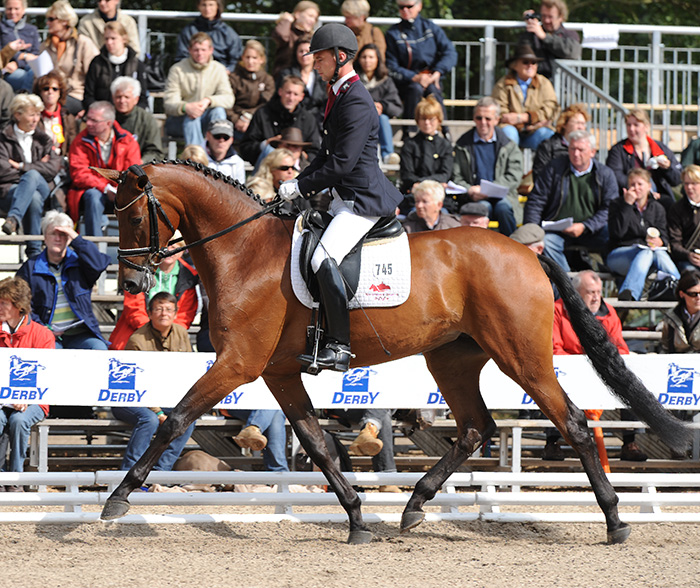
This means that although you use elements of the straightening work right from the beginning even when working the green horse on the lunge, to be able to really concentrate on straightening your horse, you need to first establish the rhythm, relaxation, and the acceptance of the bit. Generally the horse must be strong and prepared sufficiently to develop enough impulsion. In other words, the horse must have developed gymnastically and athletically.
The horse must be able to carry himself and move forward in a supple and elastic manner, full of energy, but relaxed, allowing the fluid movement to flow through his body without any restriction or stiffness in any joint or muscle. Once the straightening has been established, you can concentrate more on the final aim of the horse preparation: collection.
The straightening of the horse on straight lines
Once the horse is correctly on the aids, taking the outside rein and therefore accepting the bit evenly, so as a result the rider has full control of the hind legs, we can proceed with the straightening work on geometrically straight lines. This includes the long and short sides of the arena, the diagonals, centreline, etc.
Before we begin this work, however, we need to consider the horse’s conformation and how it will affect his work. Specifically, the horse is narrower through his shoulders and wider behind at the croup. To ride the horse straight on the long and short sides, the horse’s spine must be parallel to the arena walls. Therefore, the rider has to position the horse, in such a way that the horse’s forehand is placed in front of the hindquarters.

In this way the horse’s hind legs will follow the track of the foreleg. The horse’s spine will be precisely above the line you are riding. Aim to place the spine parallel to the wall.
If you don’t take into account the fact that the horse is narrower through the shoulders than the croup, and you try to straighten the horse, you will place his outside parallel to the wall, but not his spine. Therefore you will miss the goal of riding him straight, and the horse will continue to move in his usual crooked position.
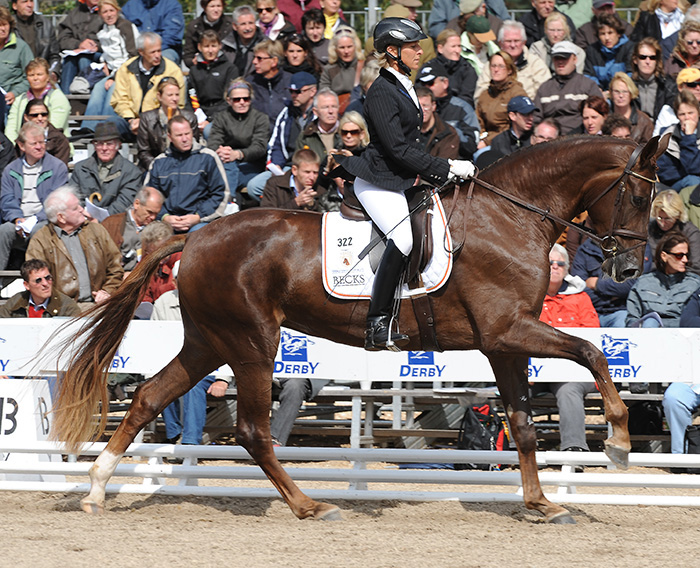
Before we continue, we need to answer the question ‘why is it important to straighten the horse?
The answer is because only if the horse is straight will the impulsion created by the hindquarters flow through the horse’s body. In other words, only through being straight will the energy or power generated by the horse’s hind legs being able to permeate through the entire horse – along his back, up his neck, through the poll, into his mouth, to the bit, and via the reins into the rider’s hands. The whole process will be supported by the rider’s elastic braced back, together with the leg and seat aids, and some of the impulsion will travel back the same way to the hindquarters and influence the hind legs to bend further under the horse’s body. As a result the hind legs will push more energetically into the ground and create more impulsion.
As a result of the fluid flow of impulsion through the horse’s body and the rider catching it in his hands, the impulsion is transformed into contained energy. You cannot see contained energy, but you can feel it and see the transformation it makes to your horse. He will begin to really use himself, working from behind with cadence and energy. His back will begin to swing and the rider will feel the power flowing through the horse’s body into his hands. The rider will sense that the horse is like a powerful, elastic arched spring, yet completely under control.
The contained energy is comparable to the properties of steam. It is not possible to see small amounts of steam, but if you can catch and harness it, you have an incredible force to utilize. The wonderful invisible power of steam can be compared with contained energy in a horse. Contained energy can permeate through every muscle in your horse creating those wonderful moments when the horse seems so athletic and powerful.
But before these moments can be achieved, the horse must move straight. If the horse deviates by falling in, then the impulsion won’t flow correctly through the body to create contained energy. Instead the impulsion will flow over the horse’s outside shoulder and be lost. The horse doesn’t want to go straight because in this case he has to work.
The flow of energy through his body – the transformation of the impulsion into contained energy – causes him to use himself. In this way he will have to work, so he will try to avoid the straightening, and his natural crookedness will help him. The natural crookedness will always become more noticeable when you ask the horse to do more difficult exercises, especially when he is not established, for example when you are teaching him something new.
When the horse tries to avoid straightening, he does so mainly by resisting in three different parts of his body. These are: *the hindquarters * the neck-shoulder region * the poll. Let us look at each area in more detail.
next we talk about straightening in relation to the hindquarters
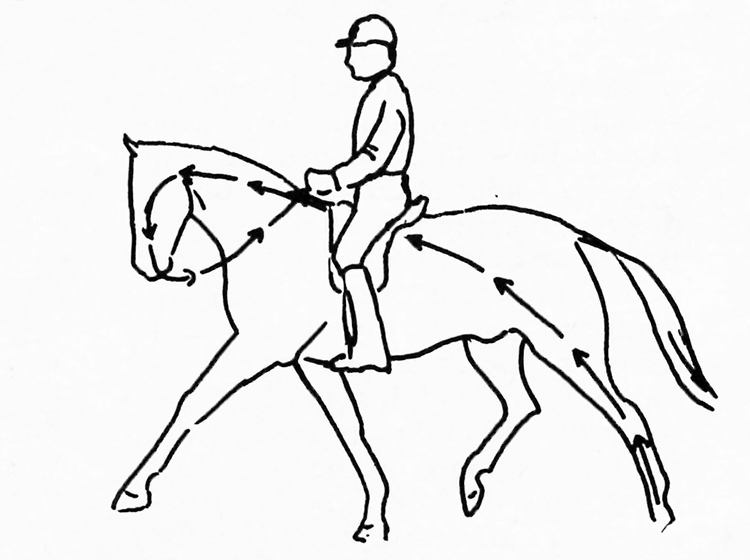
The hindquarters
The horse can avoid the straightening at the hindquarters by falling in, or sometimes out. With right footed horses this usually means the right hind leg deviates towards the right. As a result of this evasion the majority of the impulsion generated by the hind legs, especially the strong right hind leg, will not flow through the horse’s body, into his mouth and into your hands via the bit and the reins.
Instead the impulsion will travel on an oblique path over the horse’s outside shoulder and be wasted because it cannot be generated into contained energy.
Let’s use another analogy with steam to illustrate this. Imagine you have caught an amount of steam in a container. You wish to use the steam to create energy to power movement, but instead somebody makes a hole in your container … psssssssh … all the steam leaks out and you are left with nothing! No power and no energy.
This is similar to what happens to the impulsion when your horse avoids the straightening by falling in or out. What do you have to do to try and correct this? First, let us look at how we should prevent the horse from evading with his hindquarters if the rider feels the horse has the tendency to try. The rider should use a firmer (definite) leg aid, if necessary slightly behind the girth, on the side the horse is trying to fall in on.
If the right-footed horse succeeds in cheating the rider by actually falling in, you will feel the crookedness on the right rein in the following ways:
* the horse will fall over his left outside shoulder and therefore stiffen his left side and lean on the left rein
* the horse will hollow the right side of his neck and be reluctant to take the contact with the right rein.
If this happens with a more advanced horse it will be sufficient for the rider to increase the pressure with their inside (right) leg aids and ride the horse into the outside rein. The moment the horse correctly accepts the contact with the outside rein he will automatically take the bit, and the rider will be able to influence the hind legs, and straighten the horse. As a result the impulsion will successfully flow through the horse’s body and contained energy will be created.
If you find this correction was not successful, stop riding on straight lines and ride on a circle. Try, with the appropriate aids (similar to leg yield or shoulder-in), to ride the horse into the outside rein. When you have achieved this, go back to riding on straight lines and you should find the horse remains straight. It is unlikely that a right-footed horse will try to fall out rather than in on the right rein because of the restrictive influence of the wall. However, if it does happen, correct it by using strong outside leg aids.
When riding a right-footed horse on the left rein, the horse will be more likely to fall out, especially in the corners. The rider should be aware of this tendency and prevent it with their right leg positioned behind the girth. With a young or green horse you may have problems trying to correct him or to teach him to go straight using these methods. This is because on the right rein a right-footed horse attempts to use the crookedness as an evasion by falling in. The horse will fall over his left shoulder and look for support in the left rein. If you try to ride him into the outside rein you may not correct the falling over the left shoulder at all. Indeed it is possible to make it worse.
Instead the best way to correct or teach a young right-footed horse is for the rider to keep the left hand passive in the turns (ie. corners), or on the straight lines by maintaining a light connection (slight contact) with the horse’s mouth. The rider needs to place the horse’s forehand in front of the hindquarters by leading the forehand slightly to the right. To do this the rider uses an active opening influence of the right rein (not by opening the fingers but by taking the right hand away from the horse’s neck towards the inside of the arena).
The right rein needs to be shortened. This will place the forehand in front of the hindquarters, so the hind legs step in the lines of the forelegs. It is important to remember that you need to keep actively riding the horse forward using your legs and seat.
If a right footed green horse is ridden on the left rein it will show the same inclination but in a reverse way. In other words, the right hind leg, which is the leg with the problems, is now on the outside and will not follow the line of the right foreleg. As a result the horse will load his left shoulder and have the tendency to increase his speed and fall on his forehand. This will be more obvious when riding on circles or through corners, the stiffness on the left side will appear accentuated, as will the leaning or searching for support on the left (inside) rein. Also the horse will feel even hollower on the right side, and will avoid taking the contact with the right rein.
The first stage in correcting this is through influencing the horse with the right rein. The aim is to place the horse’s forehand in front of his hindquarters. This will counteract the horse’s tendency to increase his speed.
The rider’s right leg should remain behind the girth to prevent the tendency of the horse’s right hind leg to deviate towards the outside. However, in this case it would be incorrect for the rider to use a forward driving influence with their right leg until the horse has been straightened because it would increase the hose’s crookedness by encouraging him to fall over his left shoulder.
The rider’s left leg, in conjunction with the right outside leg, will encourage the horse to bend longitudinally, and therefore the horse’s hind legs will follow the lines of the forelegs. The horse’s spine will be in line with the ridden lines, and therefore the horse will be straight and the impulsion will flow through his body. Now the rider’s right leg must not only continue to prevent any deviations of the horse’s right hind and maintain the longitudinal bend.
The right leg should also push the horse’s right hind leg under the horse’s body, and, in conjunction with the rider’s left leg, through the alternate forward driving aids, create a good rhythm and influence the activity of the hindlegs, therefore creating more impulsion.
The rider’s right leg has a dual task, as it must prevent any deviations of the horse’s right hind, and generate the creation of impulsion in the hind legs in synchronization with the left leg. This is done through the alternate forward driving aids. With a very green horse I suggest that the first attempts in the straightening work should be done at the rising trot.
But always remember – only after the horse has been straightened can you truly achieve the final step on the training scale – collection.
This article first appeared in the December 1989 issue of THM.
Breed to one of the dressage stars available from International Horse breeders there’s a wide range available – go to www.ihb.com.au
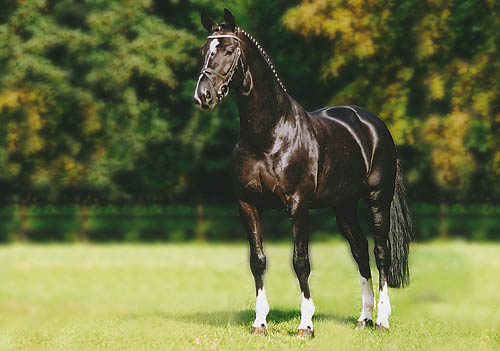
De Niro



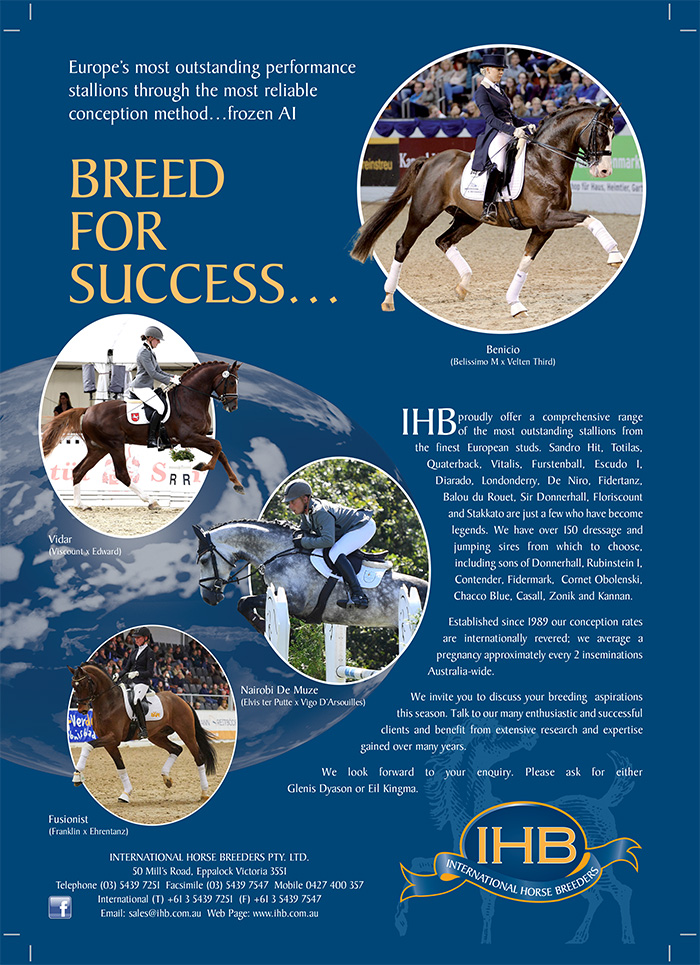
Love these articles – really helpful thank you
Naomi
Excellent article its time many instructors need to understand this in the training of the horse and rider..